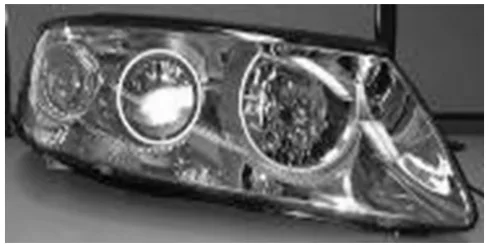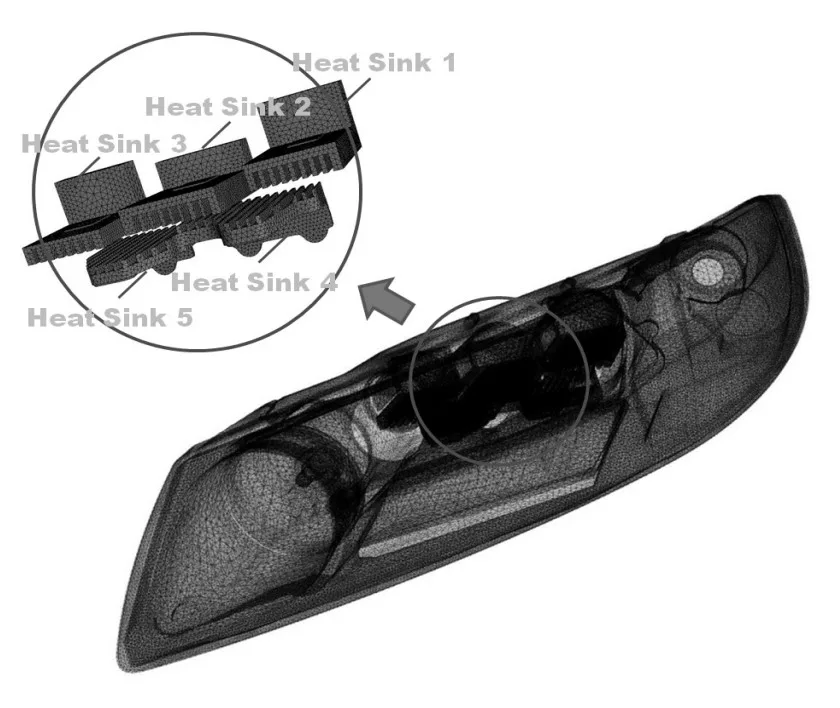This article introduces the paper "Cooling Performance of LED Head Lamp with Heat Sink and Cooling Fan".
1. Overview:
- Title: Cooling Performance of LED Head Lamp with Heat Sink and Cooling Fan
- Authors: Manseok Ko, Juhan Lee, Sangjune Oh, Hyenseok Cho, and Teabeom Seo
- Year of Publication: 2009
- Journal/Conference: Journal of the Korean Society of Mechanical Engineers, Part B
- Keywords: Head Lamp, Free Convection, Forced Convection, Cooling, LED
2. Research Background:
The increasing use of LEDs in automotive lighting systems presents a challenge due to heat generation from high-power LEDs, leading to performance degradation and reduced lifespan. Previous research identified factors affecting LED lifespan and analyzed heat transfer characteristics through heat sink design modifications. However, these studies lacked optimal cooling system designs to mitigate performance degradation caused by high temperatures.

3. Research Objectives and Questions:
- Research Objective: To determine the optimal design of a cooling system (natural convection/active convection) for high-power LED headlamps through numerical analysis. The study aims to establish a correlation between heat sink area and coolant flow velocity, and propose an optimized cooling solution for LED Head Lamps.
- Key Research Question: What is the effect of heat sink area and fluid velocity variations on the LED junction temperature in both natural and forced convection cooling systems?
4. Research Methodology:
- Research Design: Numerical analysis using STAR-CCM+ (Ver. 3.02)
- Data Collection Method: Numerical simulation based on a commercially available headlamp model (90% similarity to the actual geometry).
- Analysis Method: K-Epsilon turbulence model was used, considering natural and forced convection, buoyancy, and radiative heat transfer. A mesh of 1.25 million cells was employed. Polyhedral Mesh with Layer (Trimmed mesh) was applied near the walls for accurate wall temperature gradient.
- Research Subjects and Scope: Commercial headlamp; variations in heat sink area (0.0958m², 0.479m², 1.0538m²) and fluid velocity (2.20m/s, 3.30m/s, 4.40m/s, 8.80m/s).

5. Main Research Results:
- Key Findings: Natural convection alone proved insufficient to maintain the target junction temperature of 130℃. Forced convection showed improved cooling performance with increased fluid velocity, reaching a junction temperature of 111℃ at the maximum velocity (8.80 m/s). Junction point 1 showed the lowest temperature, while points 2-4 exhibited higher temperatures.
- Statistical/Qualitative Analysis Results: Figures 1, 2, 5, 6, 7, and 8 in the original paper provide detailed results. (Refer to the original paper for figure descriptions).
- Data Interpretation: Natural convection cooling is ineffective, while forced convection cooling shows limitations even with increased velocity. Improved flow path design is crucial.
6. Conclusions and Discussion:
- Summary of Main Results: Natural convection cooling is impractical; forced convection cooling shows limitations despite velocity increases. Improvements in flow path design and cooling system are needed.
- Academic Significance: Provides fundamental data for the design of LED headlamp cooling systems.
- Practical Implications: Emphasizes the need for efficient cooling system design in LED headlamps, focusing on improved flow paths and fan placement.
- Limitations of the Study: Further experiments and numerical simulations are required to enhance the reliability of the numerical model.
7. Future Research:
- Future Research Directions: Research focusing on improving heat sink cooling performance through flow path optimization and fan placement variations. Enhancement of numerical model reliability through repeated experiments and simulations.
- Areas Requiring Further Exploration: Evaluation of cooling system performance under actual vehicle operating conditions.
8. Summary of References:
(1) Lee, D. G., Roh, D. S., Choi, J. B., Dong, S. G., and Ko, C. B., 2006, "Micro Heat Dissipation Technologys for High Power LED ( )," KIER p. 172.
(2) Aimal, A, Mitch, S. and William. I., 2007, "Towards Developement of Thermal Standards for the Design of LED Lamps," SAE Technical Paper Series NO. 2007-01-1037.
(3) Yu, H., Freyssinier, J. P., Deng, L., Narendran, N. and Gu, Y., 2004, "Solid State Light: Failure Analysis of White LED's," J. Crystal Growth, 268, pp. 449~459.
(4) Kang, H. W., Park, K. S. and Kang, B. D., 2007, "The Effects of the Second heat Source on Heat Sink of LED Head Lamp," KSAE07-S0179 p. 1152.
Copyright and References
This document is based on the paper "Cooling Performance of LED Head Lamp with Heat Sink and Cooling Fan" by Manseok Ko et al.
Source: DOI:10.3795/KSME-B.2009.33.12.947
This material is a summary based on the above paper and its unauthorized use for commercial purposes is prohibited.
Copyright © 2023 CASTMAN. All rights reserved.